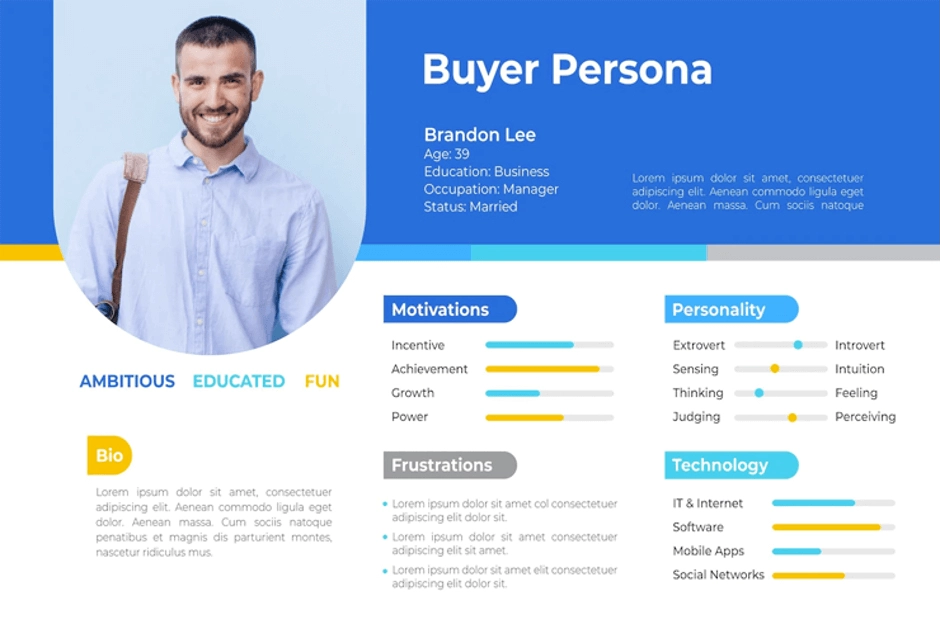Without understanding their target audience, businesses risk developing apps that don't resonate with users, accrue negative feedback, and have low monetization. That's where user personas, imaginary profiles based on audience insights, help guide UI/UX decisions. Our blog post provides a step-by-step guide to creating these personas and traces 7 of their most compelling benefits.
App development is a long and demanding process in which everything needs to be perfectly
planned in order to make it successful. The UX/UI, coding language, back-end, database, as
well as user persona needs to be ascertained before the actual process begins. In this blog,
we will closely examine why creating a User Persona prior to App development is so
important.
“Global mobile app downloads reached 230 billion in 2021, up by 63% from 140.7 billion in
2016”
-
Statista
What is mobile app user persona?
A user persona is an artificial character that has been created with data analysis and has
wants, needs, likes, and dislikes. User personas help app development teams come up with a
product that will satisfy the user’s requirements. The wants and characteristics of User
Personas represent the needs of a larger group. User personas shape the foundation of UX
design. For mobile app development,
user research forms a key component of product decisions.
This makes developing user personas very critical before going into the actual app development
process. Many apps fail because they don’t consider the user’s characteristics before going into
development. An app that is developed keeping in mind the user persona has a much bigger chance
of becoming successful. Careful planning and research must be done before the
mobile app development
process. User persona may not just have one avatar, but there can be several avatars who are
going to use the app. You can even get in touch with real people who are similar to the persona
you have created and find out about their preferences.
Steps for creating a user persona
1. Collect Data About the Target Audience
The first step is to conduct user research to learn about their behavior, motivations, and
mindset. Most accurate personas are based on field data collected through interviews and
observations.
2. Identify Behavioral Patterns from the Data
The next step is to analyze the data collected and group similar people together. This
grouping is based on behavioral patterns and trends observed.
3. Create Personas & Prioritize Them
Once the data has been collected and analyzed, personas can be created out of the findings.
In most cases, several personas can be created by the researcher, but it is recommended that
you priortize a few of them.
4. Share the Characteristics with the Team & Generate Consensus
Once the User Personas have been finalized, they need to be shared with the mobile app
development team to develop a consensus regarding their characteristics.
Types of user personas
- Proto Personas:
These personas are based more on assumptions than on research. They are used for quick representations
where doing comprehensive research is either not possible or required.
- Qualitative Personas:
These are based on small groups of people and may use surveys, interviews, and usability tests
to collect data for creating personas.
- Statistical Personas:
These personas are based on both qualitative and quantitative research. These personas are
more accurate and informative, but the process is expensive and time-consuming.
Advantages of creating user persona
1. Better UX/UI Design of the App
Instead of just relying on your intuition for the layout, User Interface, design, and colors
to use in the app, it would be better to design them according to the preferences of the
User Persona created for the app. This will make the app much more attractive to the target
audience, who will download the app and make use of it. Although incorporating all
preferences may not be technically viable, incorporating whatever is possible will attract
the target audience.
2. No Confusion Amongst App Development Team Members
In any mobile app development team, there will be members
with varying degrees of expertise and experience. More often than not, there will be a difference
of opinion amongst them. In order to agree upon features of the app, there needs to be consensus,
which can happen only if the personas of the app user are known before development. With User
Personas in mind, team members can sit together and decide the features of the app.
3. For Building User Empathy
Empathy is critical in the case of a user-centric design. Successful products have personal
relevance and are in tune with the users. It is necessary to find out what impression the
product is leaving on its users. This will make the difference between the apps which users
visit often and the ones which they uninstall. App developers have to step out of their
shoes and step into a user’s shoes if they want to create a successful app.
4. Site Architecture & Other Technical Aspects
Assuming the user persona clearly depicts the user, technical aspects of the app can be
fixed after deciding on the user interface and user experience. This will save a lot of time
because, without user personas, there will be a lot of trial and error. The company that
owns the app will have to spend more resources on it if it needs to be reworked after
launch.
5. For a Better App
Personas are easy to remember, which helps designers to keep the user’s perspective in mind
in a way that other user research methods cannot. This allows the designers to think about
the app with the right set of constraints and evaluate features accurately. With a clear
understanding of the end user, elements of the app can be customized as per the user’s
needs. It also allows the designers to anticipate what issues the users may face in the
future.
6. For Better Product Positioning
Creating products that are targeted toward a specific group from the very beginning ensures
that the product is valuable and relevant to them. A nicely crafted product generates a
positive vibe amongst the users. Hence, when a company needs to promote a product, brands
are able to create a strong positioning within the niche. This reduces time to market as
marketers already have the groundwork laid out beforehand.
7. Leads to New Concepts & Ideas
As the User persona helps in making the workflow smooth and in easier decision making, it
can lead to new concepts and ideas. User personas allow the firm to take calculated risks
and informed decisions, all of which directly impact the business. This approach has far
better chances of making the app a successful one as compared to those developed without
keeping user personas in mind.
On a closing note...
User Personas are the foundation of good UX/UI, and creating accurate User Personas is the
key to a successful app. It saves a lot of time and resources as decisions are made based on
the characteristics of the User Persona and not on what the app developers think is correct.
So, creating user personas prior to app development has several advantages, and all apps
must be developed taking into consideration the former.


